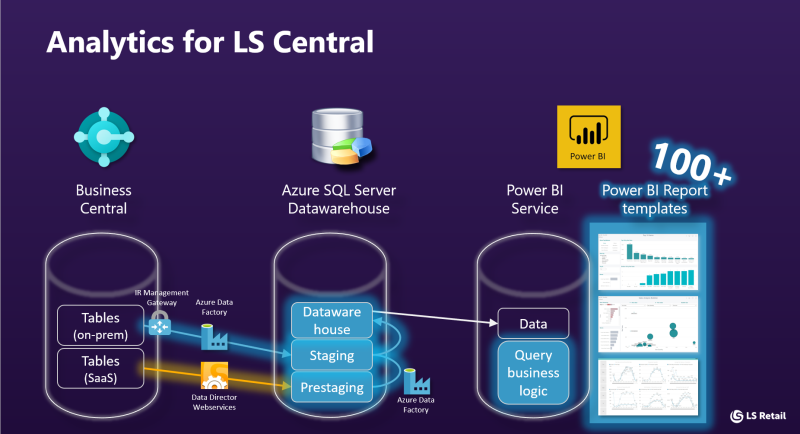In this article
Architecture and technical overview
Analytics for LS Central is a BI solution that gives you access to an extensive suite of data analysis power and reporting options for LS Central data, with none of the complications attached to building your own data warehouse.
Analytics is built by LS Retail on Power BI, which is Microsoft’s Business Intelligence service in the cloud. When you use Analytics, you get access to reporting optimized data sets, and to all the Microsoft Power BI reports with their advanced calculations and relationships. It can be set up for LS Nav and LS Central on-premises from version 8.4 to the current versions, and for latest versions of LS Central SaaS.
When you have registered for a license, through the LS Retail License department, you can download the product package free of charge, to use as is, or as a base for your data warehouse and Business Intelligence environment.
For a more high-level description of the Analytics product or to request a demo, consult LSRetail.com.
Architecture and technical overview

The Analytics for LS Central architecture consists of a few components that are shown in the image above and can be explained from left to right.
Business Central - LS Central
First, you have the LS Central source database. This is your LS Central BackOffice database and it can be located in Azure, on a virtual machine, or on an on-premises server. In the onboarding process these platforms for LS Central are referred to as "on-premises" as they all use the same connection methods.
If the LS Central database is on-premises, the Integration runtime management gateway needs to be set up on a machine that is always running. We recommend that this is not the same machine the SQL server is running on, but it should be in the same domain as the LS Central SQL server.
If LS Central is running as SaaS, an extra step is needed in the loading of the data from LS Central to Analytics. For that step you need to set up Data Director and an on-premises instance of LS Central that is used only for controlling the replication of the data from LS Central SaaS to the pre-staging tables in the data warehouse in Azure. This extra step is needed since there is no direct query access to the LS Central SaaS database.
The Azure Data Factory v.2 contains all the pipelines that collect and load the data from LS Central into the data warehouse and to load data from the staging table to the dimension and fact tables. It does not matter where the data warehouse is located, the Azure Data Factory will always need to be set up and run in Azure.
Azure SQL Server - Data warehouse
The data warehouse dimension and fact tables, designed in a star schema, are stored in the Analytics SQL database. The same database also contains the Pre-staging and staging tables used in the data loading process. The pre-staging and staging tables are created automatically by the onboarding process, while the dimension and fact tables that make up the data warehouse are included in the database backup that is restored during setup.
We recommend storing the Analytics database in Azure, but for LS Central on-premises you can also set up the database on an on-premises server.
Power BI service - Data model and reports
With the Analytics setup you get the Power BI templates containing the data models and reports. Currently, currently there are five standard templates for Sales, Inventory, Supply chain, ACI, and Hotel reporting. The templates need to be connected to the Analytics data warehouse database and can then be published to the Power BI service where administrators can publish apps and share them with different users within the organization, such as managers and those in charge of purchases and employees, for example.
Setup and onboarding
All of these Analytics components can be set up in a few simple steps that require no in-depth knowledge of data warehouses, report building, or Azure. The data warehouse has been designed by LS Central BI experts and the reports are already created. We have done the work for you and now offer a solution that can be set up from beginning to end within a couple of days.
Everything you need to know about the setup and running of Analytics for LS Central is explained in the onboarding process. You can also watch a recording of a webinar that presents an overview of the product and explains how to get started.